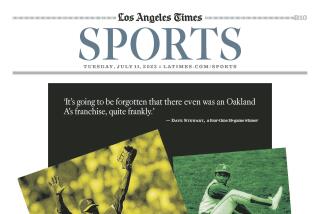N.Y. Times Ushers Out Section on Attacks
- Share via
As of Tuesday, readers of the New York Times opened their papers to find an absence. The special “A Nation Challenged” section, which the Times quickly established as a daily chronicle of war, mourning and restoration, has gone out with the old.
These issues, which stood alone in the newspaper for the past few months, “have become woven into all aspects of national and international life,” said Monday’s editor’s note, which announced the special section’s cessation on its front page. “The new year provides an occasion to reflect that evolution by incorporating the coverage into the paper’s main sections.”
The section was launched one week after terrorists struck the World Trade Center just a few miles south of the Times’ 43rd Street headquarters. But as grief recedes for those readers only indirectly affected by the tragedy, as New York is restored to peacetime conditions, and as the economy continues its sluggish slump, the advertising-free section bids the city adieu. Some editors cite reader fatigue of the unrelenting coverage, and others cite editor fatigue after three months of unyielding work in the newsroom, in the streets of New York and abroad in Europe and the Middle East.
It has been the only daily special section in an American newspaper devoted to coverage of the terror attacks’ aftermath, weaving together local and international reporting, which are usually presented in separate sections. For many New Yorkers, the section has been synonymous with crisis coverage, and its cessation will probably be considered a symbol of the city’s shift into more peaceful times.
The section has won accolades from even typically contrarian figures like Rupert Murdoch--owner of the New York Post--who admitted on the Charlie Rose show that the Times’ staffers “have just pulled on all their huge resources and done a fantastically good job.”
“I think that years from now it will be seen as a kind of stunning high point for the Times, and perhaps even for American journalism,” says media critic Jay Rosen, who will be sorry to see it end. Rosen, chair of the media department at New York University, says a good deal of the section’s effectiveness lies in the blend of local stories with the larger international scope. “Having all these articles on a big, complicated story in one place invites the reader to draw connections. Reading it is a kind of act of coherence-making--news is usually so fragmented.”
But media critic Danny Schechter, executive editor of Mediachannel.org, has found the grouping of related stories in one section problematic. “I think it’s a sort of ghettoizing of the coverage, so if you’re not interested in it, you’re just not going to look at it. You’re not going to happen upon it elsewhere in the paper.” Schechter says his acquaintances at the Times have also been critical of the section, referring to it as the “landfill” section. “They’ve got a point,” he says. “It’s certainly a landfill of information.”
The section has not only functioned as a forum for national and international reporting and analysis, but has also been a reservoir of focused personal mourning. The section has been a home to more than 1,800 obituaries of people lost in the attacks in special feature titled “Portraits of Grief.” As new names and stories emerge about those killed Sept. 11, the Times expects to run additional tribute pages. And the portraits published in 2001 will find a permanent home in a hardcover book to be published this spring. The book’s profits will be donated to a Times charitable fund.
In some ways, the end of this section can be seen as difficult task of line-drawing in a complicated time. Perhaps it’s an affirmation of sorts that top editors feel its time to return the paper to its previous format for the new year. Or maybe it’s evidence of one crisis outweighing another one: Perhaps the expense of providing special coverage in especially bad economic times has just become too tough to bear.
“A Nation Challenged” will continue as a heading in the paper’s front section, lest anyone consider the challenge abated. And the Times has publicly reserved the right to resurrect the section in the event, as the editor’s note put it, of “another overwhelming news development, transcending all boundaries.” With terms such as these, let’s hope this farewell is as irreversible as the one we’ve just bid to a challenged year.
More to Read
Sign up for Essential California
The most important California stories and recommendations in your inbox every morning.
You may occasionally receive promotional content from the Los Angeles Times.













